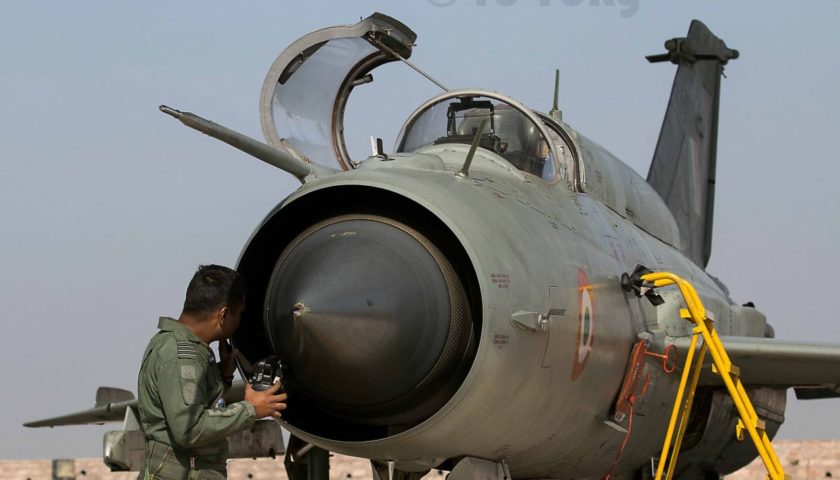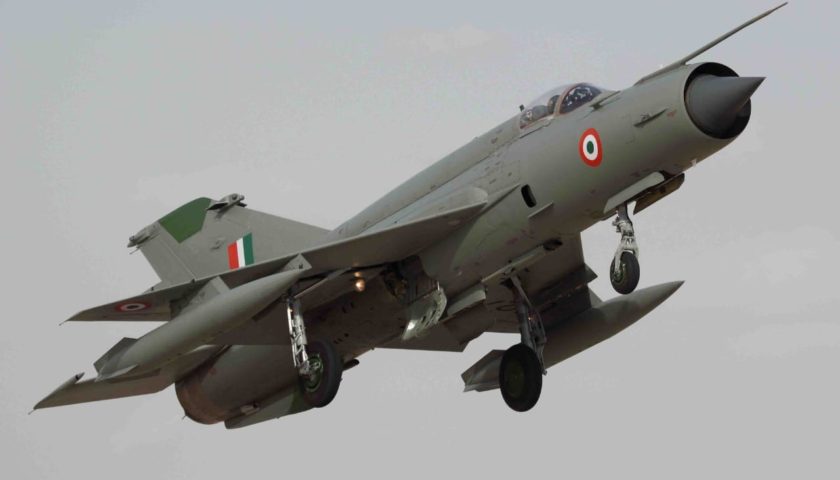The most widely produced supersonic jet fighter of all time, the MiG-21 (Western reporting name Fishbed) is an incredibly prolific aircraft. Dated but nimble, it has allowed skilled pilots in past decades to defeat more advanced aircraft. Though its days look to be numbered. To me, it does not. I think it will continue to live in the heart of pilots and adversaries alike for decades to come.
Single-seat, single-engine, supersonic, all-weather, day-night capable, jet fighter aircraft produced by the Mikoyan-Gurevich Design Bureau was an improvement on prior generations of the MiG-17 and MiG-19.
The MiG-21 holds the record for the most-produced jet aircraft. More than 10 000 units were produced (counting Chinese production).
MiG-21 Specifications.
Height: 13 feet 6 inches (4 m) Length: 47 feet 7 inches (14.5 m) Wingspan: 23 feet 6 inches (7.154 m) Empty Weight: 12,880 lbs. (5,846 kg) Loaded Weight: 19,425 lbs. (8,825 kg) Maximum Speed: 1,351.48 mph (2,175 km/h, Mach 2.0) Range: 751 miles (1,210 km) off of internal fuel Service Ceiling: 58,400 feet (17,800 m) Crew: 01

Unique Advantage.
The MiG-21 first saw widespread military action against the F4 Phantom of the USAF during the Vietnam War. Its speed and manoeuvring capabilities made it a very formidable foe for the United States Air Force in the air to air combat. More recently we have witnessed the use of the MiG-21 by the Syrian government Air Force to fight rebel targets and to also destroy ISIS on the ground in the Syrian Civil War of the second decade of the 21st century.
Despite technological improvements to the avionics deck, most modern third and fourth generation fighters could not surpass the MiG-21 in terms of speed. While they have advanced systems for detection, evasion, and targeting, they cannot outrush or outmanoeuvre this aircraft. In addition, it had unprecedented versatility (multirole capability) which is unparalleled to my mind. In simple words, it could accomplish roles of fighter, interceptor, or serve as a tactical bomber in a ground attack role by carrying rockets and bombs.
Cheap But Reliable.
Since its first flight, it has been extensively sold to air forces around the world. Though it doesn’t possess the electronic warfare capability, modern avionics suite, or weapon capability it has proven to be reliable, rugged, and offers a versatile platform to take on jets in the air, and also attack ground positions. For most developing countries, they may not simply want the most technologically advanced aircraft, but one which simply works. The MiG-21 fits the bill.

What I learned.
Success is no accident. It is hard work, perseverance, learning, studying, sacrificing, and most of all, love of what you are doing or learning to do.
- MiG 21 was the first fighter aircraft that I got a chance to fly. The rules were made very clear to us before we were allowed to sit in the cockpit. I studied ‘Pilot Notes’ and paid attention to the minutest of details. Here I would especially like to mention that these books were literal translation from Russian to English and very difficult to comprehend. We mastered understanding Russian English. SOPs (standard operating procedures) and briefing guides were saviors but we kept reading and studying pilot notes like Bible.
- Initially the aircraft, its cockpit look menacing to me. To make the matter worse, half the switch labels in the cockpit were in Russian. The switches were thrown without any ergonomic thought to them. It was a common joke that western aircraft were designed around the pilot, while Russians first designed the aircraft and then found a place to fit the pilot. We spent countless hours trying to master checks, procedures, and emergencies (non-normal situations).
- Nothing could have prepared me for the first fighter ride. We had no help, no simulators or cockpit mockup. The roar of the engine, the kick of reheat, and all the preparation evaporated in thin air. Realizing the gap between where I was and where I need to be, I felt confident that I could fill the gap. Or did I have any other choice?
- I soon learned the trick to land the aircraft at a speed that was equal to VMO of the previous aircraft. Our limbs grew to become the landing gears and this new perception assisted in landing though a very scary idea. To us it seemed, the pitot tube was a gift which we had to point on the threshold for the approach to landing.
There is no substitute for hard work. Never stop believing. Never stop fighting.
- With the most rudimentary navigation system, flying at low levels, I soon learned to make good target on time. We devised ways to fly more accurately than what our instruments could tell us. The least count of ASI at tactical speed was 50 Kmph, while the altimeter was reading sub-zero due to large position errors and compass reading was accurate to 2 deg only.
- Automatic Direction Finder (ADF) was the most advanced navigation system we had onboard. I learned to prepare and read the map. Every line was carefully drawn. Distances and angles were cautiously measured. Attention was paid to every detail of the map. This was our own ‘moving thumb map display’ during the flight where thumb kept denoting our present position on the map. The Russian stopwatch was incredibly amazing which could be misread at all times due to its presentation and location. It could throw your immaculate planning out of balance at low level.
- Taking aim with gyro gunsight required dexterity and practice which we soon mastered. We mastered gyro gun sights to achieve direct hits.
- We learned Radar work form non-existent radar. I relied more on our eyes to detect targets than on radar. I learned to sneak in from blind quarters and make a quick exit after the attack. Yes, we believed we could shoot an ASF (air superiority fighter) for that we did fly low and fast. Bingo! We thought we were invincible.
Self belief and hard work will always earn you success.
- This simple machine MiG 21 could get all these tasks executed by us with perfection. No wonder we all love her. In the young formative years, I got a chance to master shooting guns, dive-bombing, defending and intercepting. Opportunity to learn from the perspective of a defender as well as an aggressor and finally realizing both means the same.
- The MiG 21cockpit was pressurized and air-conditioned. However, temperature controls were designed for Russian winter conditions only. For Indian pilots, it meant hot, hotter, and hottest conditions only. Heat cramps and exhaustion were common amongst pilots and we took pride in walking back to flight complex with overall zip open till crotch. Those days there were no woman fighter pilots.
- The aircraft turnaround time was less than 40 minutes for most of the missions. It was a rugged and reliable machine. It took only two minutes to start and taxi out the aircraft. This gave us another advantage when compared with other Gen 3/4 aircraft fighter pilots on base. We would finish out days task in half the time they took.
“Kick the tyre and light the fire.” Summed up the actual time from external check to take off.
- In between flights, there was no time for long lengthy debriefs. It was just adequate for hot debrief, grab a sandwich and standing brief for next mission and march back to aircraft. It did not give us time to unzip our ‘g’ suits also.
Simplicity to its core.
- The ejection seat was as uncomfortable as could be and that is the reason for the short endurance of MiG 21 or we were told. The shortest flight for me with mission accomplished (1Vs 1) just lasted for 12 min from wheels up to touch down. I would go around boasting about this for months. I am sure there are thousands more who have done it in lesser than this.
Short and sweet like teenage love.
- While operating against bigger and advanced fighter MiG 21 did not offer us any protection against high ‘g’ maneuvers. We soon discovered we could increase ‘g’ suit pressure to Maximum and select 100% Oxygen for delaying the onset of greying leading to a blackout.
- The only respectable thing the MiG design bureau did after designing MiG 21, was to make the trainer even more uncomfortable and short on endurance. The trainer went ‘Thirsty’ after unstick when compared with the fighter. The rear pilot was sitting in a cocoon without any external visual references making the job even more tough for them.
- Even this short endurance was enough to give us sleepless nights when it was time for quarterly Instrument Flying (IF) sortie on MiG 21 trainer. The best of jocky remained disoriented for days after the flight due to hood which was used for simulation. It was always a celebration time when the trainer was unserviceable or hood was not available which were rare occasions.
Of all the hard job around the world, the hardest was to be an instructor on MiG 21.
- Our instructors were noble. They inspired hope, ignited the imagination, and instilled a love of learning. They not only demonstrated the toughest of maneuver with ease and comfort but shared their experience and wisdom also.
- We were aware of all the odds pitted against us. We prepared meticulously for that eventuality because we knew we would get only one chance to come out safely from such a situation. Safety was paramount.
There are many more tricks which I am sure all MiG 21 pilots would like to share and it can fill up volumes of Encyclopedia and Fighter tactics.
I love what I did.
I think of myself to be extremely lucky and fortunate person to be part of this journey.
Be safe. Happy landing.



